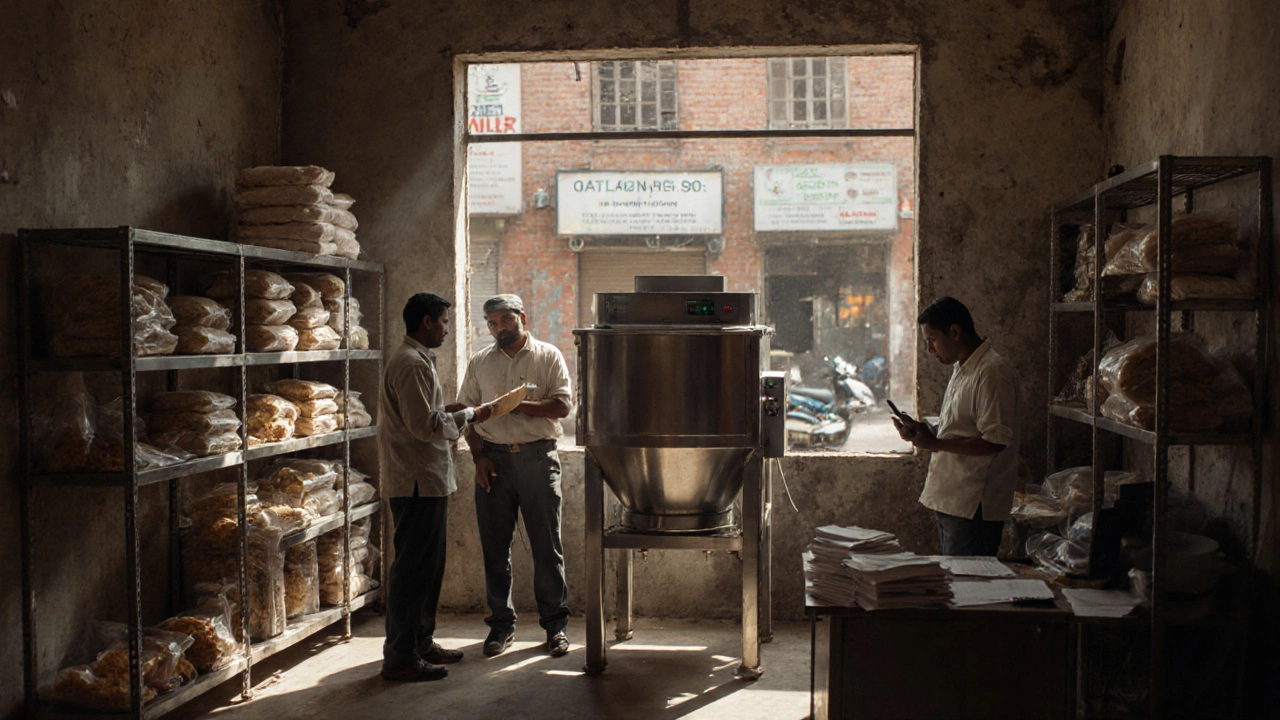Startup Capital Calculator
Estimated Startup Capital Required
Total Capital Required:
₹0
Breakdown:
- Fixed Assets (CapEx): ₹0
- Initial Operating Expenses: ₹0
- Working Capital Buffer: ₹0
Thinking about turning a hobby or a local demand into a profit‑making venture? The first question that pops up is always the same: how much money do I need to start a small scale business? The answer isn’t a single number-it’s a mix of fixed costs, working capital, and the right financing mix. Below you’ll find a step‑by‑step guide that breaks down every cost bucket, shows you where to pull the money from, and helps you put together a realistic budget you can actually stick to.
Key Takeaways
- Identify three core cost groups: fixed assets, operating expenses, and working capital.
- Calculate a minimum cash buffer of 3‑6 months of operating costs.
- Explore four main funding sources: personal savings, bank loans, government schemes, and angel/venture financing.
- Use a simple break‑even model to confirm your capital requirement.
- Follow the checklist at the end to avoid hidden expenses.
1. Define Your Business Model and Scope
Before you write down any numbers, you need a clear picture of what you’re building. Are you opening a food processing unit that makes snacks for local schools, or a home‑based textile stitching service for custom garments? The industry, location, and scale dictate the cost structure. Sketch a one‑page business plan that lists your product, target market, sales channel, and rough revenue forecast. This plan will be the reference point for every cost you calculate.
2. Break Down the Cost Categories
Most small scale startups fall into three buckets:
- Fixed assets - equipment, lease deposits, licences, and any one‑time setup fees.
- Operating expenses - rent, utilities, salaries, raw material, marketing, and insurance.
- Working capital - cash needed to keep the business running until cash flow becomes positive.
Let’s look at each in detail.
2.1 Fixed Assets
These are the items you buy once and use for years. Common examples for a small scale operation include:
- Machinery or kitchen equipment (e.g., a 2‑tonne mixer for a snack business - approx.₹3.5lakh).
- Furniture and fixtures (office desk, shelving - ₹45,000).
- Initial licences and registrations (FSSAI for food, GST registration - ₹20,000).
- Security deposit for a commercial space (usually 2‑3 months’ rent - ₹1.2lakh for a 1,500sqft shop).
Sum these up to get your capital expenditure (CapEx). For a modest food processing unit, CapEx often lands between ₹5lakh and ₹8lakh.
2.2 Operating Expenses (OPEX)
These recur every month. The most common line items are:
| Expense Type | Average Cost (₹) |
|---|---|
| Rent (commercial) | 60,000 |
| Utilities (electricity, water) | 12,000 |
| Raw material (per month) | 80,000 |
| Labor (2 operators + 1 admin) | 50,000 |
| Marketing & promotions | 15,000 |
| Insurance & compliance | 8,000 |
| Miscellaneous | 10,000 |
Adding these numbers gives a monthly OPEX of roughly ₹2.35lakh. Multiply by 12 if you want a yearly view.
2.3 Working Capital
Working capital is the cash cushion you keep to cover the gap between cash outflows (expenses) and inflows (sales). A common rule for small scale startups is to have 3‑6 months of OPEX on hand. Using the ₹2.35lakh figure, you’d need between ₹7.0lakh (3months) and ₹14.0lakh (6months). This buffer protects you from delayed payments, seasonal dips, or unexpected repairs.

3. How Much Total Capital Do You Need?
Now add the three components:
- Fixed assets (CapEx): ₹6lakh (mid‑range estimate)
- Initial operating expenses (first 2 months): ₹4.7lakh
- Working capital buffer (4 months): ₹9.4lakh
Grand total ≈ ₹20lakh. This number will vary based on industry, location, and scale, but it gives a solid ball‑park for most small businesses in Indian Tier‑2 cities like Bangalore suburbs.
4. Funding Sources - Which One Fits Your Situation?
Having a target figure is half the battle; the next step is finding the money. Below is a quick comparison of the four most common sources for Indian entrepreneurs.
| Source | Typical Availability | Interest / Cost | Time to Obtain | Ideal For |
|---|---|---|---|---|
| Personal Savings | ₹5‑20lakh | Zero interest | Immediate | Low‑risk, quick start |
| Bank Loan (SME) | ₹10‑50lakh | 9‑13% per annum | 2‑4 weeks (if collateral ready) | Established credit history |
| Government Schemes (e.g., MSME Credit Guarantee) | ₹5‑30lakh (subsidised rates) | 5‑9% (often with subsidy) | 1‑2 months (paperwork heavy) | First‑time entrepreneurs |
| Angel / Venture Capital | ₹25lakh‑₹2crore | Equity stake 10‑30% | 1‑3 months (due diligence) | High‑growth, tech‑oriented ideas |
Mix and match. A typical starter might use personal savings for the first ₹5lakh, apply for a government credit guarantee for the next ₹7lakh, and keep a small bank loan as a safety net.
5. Leveraging Government Schemes
India offers a suite of programs aimed at reducing the capital barrier for MSMEs. The most relevant for a small scale venture are:
- Pradhan Mantri Mudra Yojana (PMMY) - loans up to ₹10lakh with minimal documentation.
- Credit Guarantee Fund Trust for Micro & Small Enterprises (CGTMSE) - covers up to 85% of the loan amount, reducing collateral demand.
- Technology Upgradation Fund Scheme (TUFS) - subsidies for modern equipment (up to 15% of cost).
Eligibility typically requires registration as an MSME, a feasible business plan, and a basic credit history. The application process can be handled through your nearest bank or online portal; expect about 20‑30 days for approval.

6. Building a Simple Break‑Even Model
Crunching numbers helps you verify that the capital you’re raising is realistic. The break‑even point (BEP) is where total revenue equals total cost. Use the formula:
Fixed Costs ÷ (Price per Unit − Variable Cost per Unit) = Units to Break Even
Example for a snack maker:
- Monthly Fixed Costs (rent, salaries, utilities) = ₹1.5lakh
- Average selling price = ₹30 per pack
- Variable cost (ingredients, packaging) = ₹12 per pack
Units needed = 150,000 ÷ (30‑12) = 9,375 packs per month, or about 313 packs per day. If your production capacity is 400 packs/day, you have a comfortable safety margin.
Adjust the numbers as you refine your pricing or negotiate better supplier rates. The model instantly shows whether your capital estimate needs to be higher (if BEP is out of reach) or lower (if you can achieve profitability sooner).
7. Checklist - Don’t Forget These Hidden Costs
- Registration fees for Shops & Establishment Act.
- Initial marketing push (social media ads, flyers).
- Contingency fund (5‑10% of total budget for unexpected repairs).
- Software tools - accounting (e.g., Tally) and inventory management.
- Training for staff on equipment safety and hygiene.
Cross‑checking each item against your budget sheet will keep you from scrambling for cash mid‑operation.
8. Next Steps - From Planning to Execution
- Finalize your business model and write a one‑page business plan.
- List every cost using the three‑bucket template (CapEx, OPEX, Working Capital).
- Calculate the total capital requirement and your break‑even point.
- Identify the funding mix that matches your risk appetite.
- Apply for government schemes while securing personal or bank financing.
- Set up a separate business bank account and track cash flow daily.
- Review actual expenses against the budget every month for the first six months.
Stick to the plan, adjust when numbers deviate, and you’ll turn that ₹20lakh into a sustainable cash‑generating business.
Frequently Asked Questions
What is the minimum amount needed to start a service‑based small business?
For a purely service‑oriented venture (e.g., consulting, digital marketing) you can often start with as little as ₹3‑5lakh, mainly covering registration, a laptop, coworking space rent, and a modest marketing budget.
How does the Credit Guarantee Fund help reduce collateral?
CGTMSE guarantees up to 85% of the loan amount, meaning banks can lend without requiring property or equipment as security. The entrepreneur only needs to provide basic documents and a viable business plan.
Can I combine a Mudra loan with a bank overdraft?
Yes, layering is common. Use the Mudra loan for capital expenditure, and keep an overdraft as a short‑term buffer for cash‑flow gaps. Just ensure total debt service stays under 40% of projected revenues.
What if my sales are slower than expected in the first three months?
Lean on the working‑capital buffer you set aside. Review your cost structure, cut non‑essential expenses (like aggressive advertising), and consider short‑term promotions to boost cash flow. If the shortfall persists, a modest bank overdraft can bridge the gap.
Is it worth paying for a professional accountant for a small startup?
Investing in an accountant early on saves you from tax penalties and helps you maintain clean books for future financing. Many freelancers offer services for under ₹5,000 per month, which is a small price compared to potential compliance fines.





